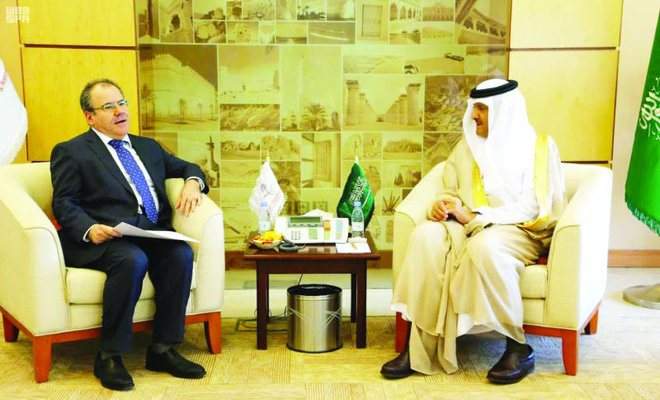
SCTNH makes quantum leap in tourism, heritage projects
This year witnessed many achievements in the tourism and national heritage sector after the Saudi Commission for Tourism and National Heritage (SCTNH) moved to the actual implementation of its projects.
Important achievements include the approval of 13 initiatives which were given the go ahead in line with the National Transformation Program at more than SR10.480 million.
The Kingdom discovered a human bone, that goes back more than 90,000 years, near the Taimaa Governorate in Tabuk Province, as announced by the commission’s president, Prince Sultan bin Salman in a speech at the French Academy for Fine Arts.
This discovery proves, along with other evidence, that the Kingdom has played a major role in human civilization throughout the ages, and is a connection point between various cultures.
This discovery is one of the important finds announced by the commission in its heritage research and technology framework carried out by 30 joint Saudi and international missions in a number of the Kingdom’s provinces.
The commission continues to cooperate with the Ministry of Islamic Affairs and Turath Charitable Institution to work on historical mosques to maintain and care for them, in addition to showing their religious and urban values.
More than 800 mosques have been included in the program and work is still underway to complete documentation. Maintaining historical mosques will be done in cooperation with the provinces’ governorates, municipalities, professional and charitable establishments, and local donors.
The commission signed an agreement with the Chinese Republic to hold the Trade Routes in the Arabian Peninsula, after the exhibition was shown in US and European museums with great success. The exhibition will start its second phase in the third quarter of 2016, and China will bring a mobile museum to Riyadh about joint culture between China and the Arabian Peninsula.
This year witnessed the launch of after-Umrah tours, implemented in partnership with the Ministries of Interior, Foreign Affairs, and Haj and Umrah. The program seeks to make the Kingdom a Muslim destination and organizes tours to various parts of the Kingdom after Umrah pilgrims complete their worship to be introduced to the history of the Kingdom and its role in serving Muslims and Islam.
Tourist festivals held this year witnessed great turnouts, with spring and mid-year festivals experiencing more than 3 million visitors, and achieving more than SR1 billion. Local tours during the summer holidays exceeded 17.8 million, with a growth rate of 44.7 percent, and an estimated income of SR20.6 billion, a growth of 53.7 percent.
The commission started working on museums and the National Transformation Program approved the support of the commission in preparing museum exhibits which stand at 18 in various parts of the Kingdom. The commission prepared a number of Islamic history museums, which are waiting for funding.
These include the Islamic History Museum which is proposed to be built in Qaser Khuzam in Jeddah; the Makkah Museum in Al-Zaher Palace; the History of the Saudi State Museum in the King Faisal Historical Palace in Makkah; and the Islamic Battles Museum, which the Custodian of the Two Holy Mosques proposed that Ministry of Defense should adopt building, in coordination with the commission. Another museum is proposed to be built at the Bader Battle location, in addition to visitors’ centers at important Islamic historical places, which represent open museums at the Ohod, Alnoor and Thor mountains. The Qur’an Oasis Museum in Madinah was proposed by Prince Sultan bin Salman; the museum will be a center to teach the Qur’an, and finally the new Railway Station Museum in Madinah.
The commission is expanding and developing the National Museum in Riyadh to suit the religious, political and cultural status of the Kingdom.
The commission signed a cooperation agreement with a number of hotels and tour companies to provide 421 jobs for scholarship students who have certificates in tourism.
The commission received commendations for its work in the national heritage field during the closing statements of the Islamic Cooperation Council summit, which was held in Istanbul on April, 15, 2016.
Souq Okaz, this year, set the cornerstone for the Future Avenue Project, which depends on participants’ input whether it is literature, products, poetry or tools. Souq Okaz had a great role in defining the role of inhabitants of the Arabian Peninsula, and tribes that participated in the Souq, which contributed to communicating between individuals and affected their futures.
The commission works in the Okaz Development Project in Taif, with a budget of SR775 million for the first phase, of which SR220 million is set for establishing the commission’s projects, and SR555 million for the basic structure inside and outside the location. The private sector is expected to participate with SR1,291 million, taking the total cost in the first phase to an estimated SR2 billion.
The Okaz City Project is expected to attract more than 260,000 tourists a year, with a contribution of SR294 million to the GDP, and will provide around 4,400 new jobs.
The National Program for Artifacts has been implemented with the signing of a mutual agreement between Bare and hotel accommodations to support Saudi artifacts.
The commission received the Electronic Pioneering Award for the third time, achieving the highest rates of e-dealings (Yasir). The commission also received the best government award for applying corporate work from the International Administrative Organization, making it the first Saudi government body that has received such an award.


























